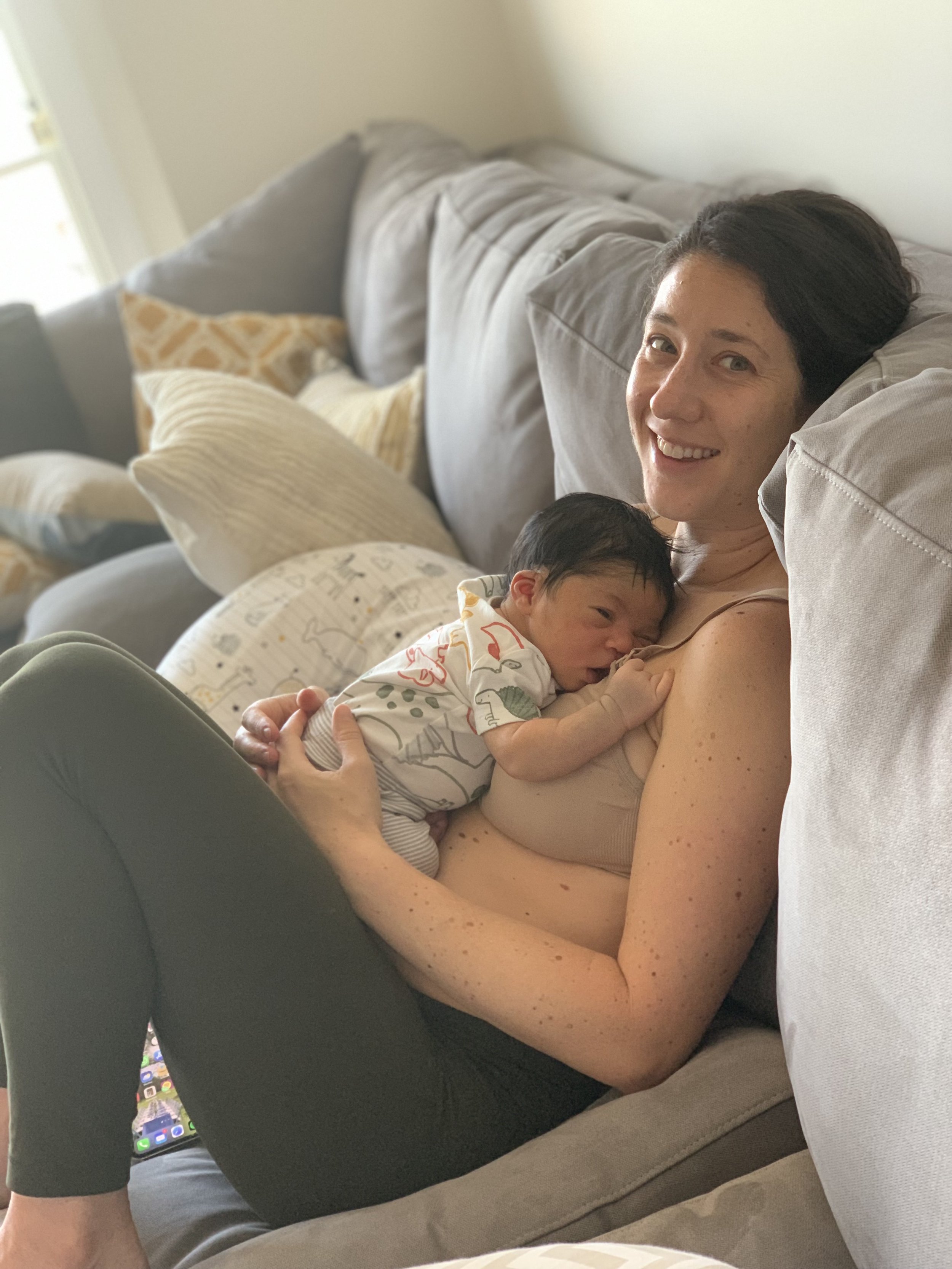Ezra’s Birth
Written by Colleen I.
Note - This is Colleen’s second post for the Mental Push Plan blog. She, like so many others, knows that the journey to parenthood is not linear, nor is it always joyous. You can read about her experience of pregnancy loss here.
Like so many birth stories, Ezra’s was different from what I had envisioned. Ezra was my second baby, and after a long hospital labor and delivery with my daughter three years earlier, I had hoped for a more peaceful delivery with less intervention this time around.
While I had hoped to be delivering at a birth center, I had a marginally inserted umbilical cord (meaning the cord was attached to the side rather than the center of the placenta).
Ezra arrived eight days after his due date. I felt lucky to be working with a midwife group who was happy to let me go to 42 weeks as long as baby and I were healthy, so I didn’t feel rushed to get him out (beyond my own physical discomfort). Still, I tried every old wife’s tale and recommendation from my doula to get him moving!
Finally, one week after my due date, I started to feel some spontaneous contractions. By that evening they were coming with more regular strength and cadence. I called our doula who listened through one of the contractions and suggested I call the midwives to let them know I may be heading in soon.
Knowing this, the midwives recommended a hospital birth as it can sometimes cause complications during labor. While it wasn’t what I had hoped for, I knew I could only enjoy a birth center delivery if I felt like it was the best and safest decision for my baby and myself. So, understanding this risk, I opted for the hospital. My doula assured me that I would still get the same care from the midwives and that the hospital was accustomed to working with them and providing a low intervention birth experience, which was ultimately what I was after.
By midnight, my contractions were coming hard and fast and we left for the hospital. I tried to sit in the front seat, but couldn’t manage to stay seated through a contraction, which were coming every 2-3 minutes at that point, so I moved to the back seat where I could move around more freely. When we got to the hospital, the poor security guard probably thought I was about to have my baby in the lobby when I stopped to kneel on the floor to get through a contraction. He rushed us right into the elevator and up to labor and delivery.
I wasn’t sure where in my labor I was, but I was intimidated by the pain I was feeling and grateful that I’d have access to an epidural if I wanted one. I felt weak for thinking of that option so soon, but I was struggling to imagine how I’d last much longer. We got situated in a delivery room with a shower and tub, and our doula met us there shortly after. When the midwife arrived, she did a cervical check and let me know that I was 5 cm dilated, which felt like a good starting place.
With the midwife and my doula there, I felt a new sense of resolve with my labor.
My husband had certainly tried his best before they arrived, but these women brought a confident, calming presence that empowered me to feel like I could labor for longer. They helped me get into new positions to manage the pain, massaged my back and legs, and encouraged my breath through the contractions. My doula had told me that this birth experience would be different than my daughter’s (which was with a traditional OB at a different hospital), and I could see what she meant right away. I felt the midwife’s support and presence through my labor in a way that I wasn’t familiar with from my first birth.
With everyone’s encouragement, I labored for another 4-5 hours of hard, painful contractions. I had packed a stack of birth affirmation cards (inspired by the Mental Push Plan and colored on by my daughter!) but I never got a chance to hang them up as I hoped. Regardless, I remembered what I had written on those cards and used them as mantras to help me through these painful hours.
The affirmations included:
“I trust my body”
“My baby and I are working together”
“I can do hard things”
I was hopeful that labor was progressing, but as we crept into the early morning hours, I could sense that nothing had really changed. I asked the midwife to check me again and was disappointed to hear that nothing had changed from when I arrived at the hospital almost 5 hours earlier. I was still 5 cm dilated.
I decided instantly and with absolute certainty that I wanted the epidural.
With my daughter’s birth, this was something I debated, consulted my “team” about, and ultimately felt disappointed about needing. My labor with her had stalled and required Pitocin to keep things moving. Getting the epidural with her delivery felt like surrendering to the intervention I was hoping to avoid. This time, I felt absolute confidence in my decision to move forward with the epidural. I had been laboring hard through the night, I was exhausted, in pain, and needed a break. Unlike my first labor, I felt completely in control of and confident in my decision at that moment. And it ended up being one of the best decisions I could have made for my labor.
Once the epidural kicked in, we were all able to take a nap. The hospital team was wonderful in giving us space to rest. The nurses let me know that they would be back in a few hours to start some Pitocin to keep labor moving, and then turned down the lights and left us alone for a few hours. Once they came back and we got the Pitocin going, it wasn’t long before I was 10 cm dilated. In talking with my doula later, she thought the epidural (and the nap shortly after) allowed my body and pelvis to relax so that the baby could descend.
The nurses lightened up my epidural so I could feel more of the contractions and asked me to let them know when I felt the urge to push. We waited and waited, but I still didn’t feel the urge to push. Soon, the baby’s heart rate was descending with each contraction, so they recommended I start pushing. I began what would result in two hours of pushing. He was “sunny side up” and didn’t seem to be in a great position to make his arrival. In these two hours, I once again felt moments of frustration, like nothing was progressing despite my efforts to push.
I had a crew of midwives, nurses, my husband, and doula all helping me to push, trying to manipulate the position of the baby, and providing encouragement and physical support through each push. It really felt like it took a whole village to get this baby out, and I felt so supported by the team of women (and my husband) who surrounded me in those hours of pushing. They were encouraging, patient, and kind throughout. At the last moment, Ezra flipped to be face down and made his long-awaited arrival in the world, weighing 9lb 3oz, and with the help of the midwives, no tearing!
I was exhausted and so proud of what I had just done.
Ezra was breathing fast in those first minutes, so they took him, along with my husband, to monitor to confirm his oxygen levels were okay (and they were). This gave me some time to debrief with my doula, which was something we didn’t get to do until later after my first birth. We used the same doula with both births, and it was special that she could share in both of those experiences with us.
I told her I didn’t think I would have survived that labor at a birth center. She and one of the midwives nearby agreed that I likely would have wanted to transfer to a hospital at some point, and that the pain relief and nap awarded by the epidural allowed me the endurance to push for two hours and the patience to not push too fast and risk tearing at the end. I already knew I made the right decision for myself, but it was validating to hear from my support team that they also thought I had made a good decision.
I had longed for a birth center delivery with my second child because of the disappointment I felt after my daughter’s hospital birth. Birthing Ezra showed me what a different and positive experience a hospital birth could be, even with medical intervention, by working with a midwife group that supported low-intervention births in all settings, and a hospital that respected their practice.




